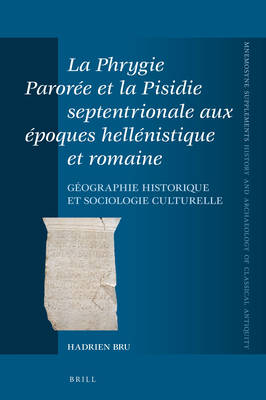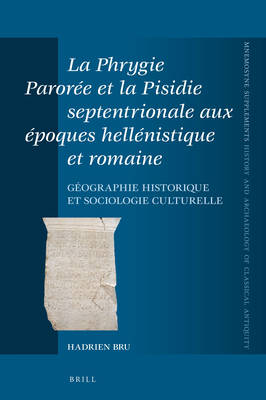
- Afhalen na 1 uur in een winkel met voorraad
- Gratis thuislevering in België vanaf € 30
- Ruim aanbod met 7 miljoen producten
- Afhalen na 1 uur in een winkel met voorraad
- Gratis thuislevering in België vanaf € 30
- Ruim aanbod met 7 miljoen producten
Zoeken
La Phrygie Parorée et la Pisidie septentrionale aux époques hellénistique et romaine
Hadrien Bru
€ 256,45
+ 512 punten
Omschrijving
La Phrygie Parorée et la Pisidie septentrionale deals with the history, the historical geography and the cultural sociology of Phrygia Paroreios and Northern Pisidia during the Hellenistic and Roman periods (IVth cent. BC - IVth cent. AD). This region of inner Anatolia, mostly inhabited by Pisidians and Phrygians, faced gradually the settlement of Greek, Macedonian, Jewish, Thracian, Lycian and Roman colonists who deeply modified the local cultures and geopolitics. With an approach based on epigraphic, archaeological, literary and numismatic sources, this work is the first historical synthesis devoted to a region showing strong cultural identities, which makes it essential to the understanding of the Graeco-Roman East.
La Phrygie Parorée et la Pisidie septentrionale traite de l'Histoire, de la géographie historique et de la sociologie culturelle de la Phrygie Parorée et du Nord de la Pisidie aux époques hellénistique et romaine (IVe s. av. J.-C.-IVe s. ap. J.-C.). Cette région de l'Anatolie intérieure, surtout peuplée par les Pisidiens et les Phrygiens, eut successivement à faire face à l'installation de colons grecs, macédoniens, juifs, thraces, lyciens et romains qui modifièrent en profondeur les cultures et la géopolitique locales. Grâce à une approche fondée sur l'examen des sources épigraphiques, archéologiques, littéraires et numismatiques, cet ouvrage constitue la première synthèse historique sur une région aux identités culturelles marquées, essentielle à la compréhension de l'Orient gréco-romain.
La Phrygie Parorée et la Pisidie septentrionale traite de l'Histoire, de la géographie historique et de la sociologie culturelle de la Phrygie Parorée et du Nord de la Pisidie aux époques hellénistique et romaine (IVe s. av. J.-C.-IVe s. ap. J.-C.). Cette région de l'Anatolie intérieure, surtout peuplée par les Pisidiens et les Phrygiens, eut successivement à faire face à l'installation de colons grecs, macédoniens, juifs, thraces, lyciens et romains qui modifièrent en profondeur les cultures et la géopolitique locales. Grâce à une approche fondée sur l'examen des sources épigraphiques, archéologiques, littéraires et numismatiques, cet ouvrage constitue la première synthèse historique sur une région aux identités culturelles marquées, essentielle à la compréhension de l'Orient gréco-romain.
Specificaties
Betrokkenen
- Auteur(s):
- Uitgeverij:
Inhoud
- Aantal bladzijden:
- 428
- Taal:
- Frans
- Reeks:
- Reeksnummer:
- nr. 401
Eigenschappen
- Productcode (EAN):
- 9789004337381
- Verschijningsdatum:
- 2/02/2017
- Uitvoering:
- Hardcover
- Formaat:
- Genaaid
- Afmetingen:
- 155 mm x 235 mm
- Gewicht:
- 787 g

Alleen bij Standaard Boekhandel
+ 512 punten op je klantenkaart van Standaard Boekhandel
Beoordelingen
We publiceren alleen reviews die voldoen aan de voorwaarden voor reviews. Bekijk onze voorwaarden voor reviews.











